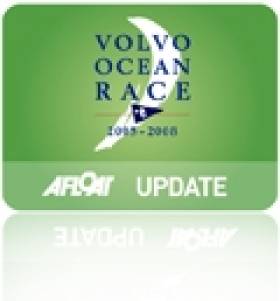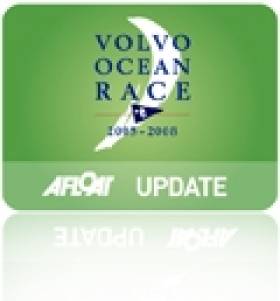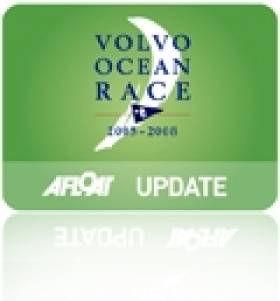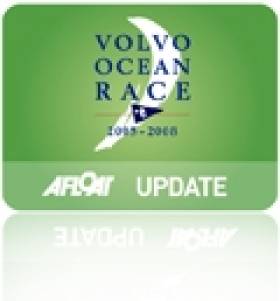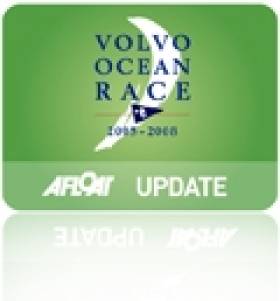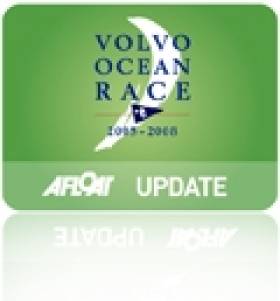Displaying items by tag: VOR
Dongfeng Win VOR Leg Three, Leading All the Way from Abu Dhabi to Sanya
#vor – It was an unbelievable end to a magnificent Volvo Ocean Race leg for Dongfeng Race Team. After leading the fleet virtually all the way from Abu Dhabi to Sanya in China, over more than 5,000 miles of intense ocean racing, Dongfeng finally crossed the finish line in first place as the sun rose over Sanya (23:31:38 UTC) in a time of 23 days, 13 hours, 31 minutes and 38 seconds.
This is the first time in history a Chinese team (or any Chinese sailor) has won a leg in the Volvo Ocean Race's 41-year history. And what a leg to win supported by its Chinese partners – Dong Feng meaning wind from the east, Aeolus (Fong Shen) meaning the Wind Guardian and the City of Shiyan.
The reality is that it couldn't have been scripted better. The Chinese team with two Chinese rookie sailors onboard – Liu Xue (Black) and Cheng Ying Kit – showed unparalleled grit and determination and led the entire fleet of some of the world's best offshore sailors to their home country China. With the ambition to 'bring offshore sailing to China' nobody could have predicted the impact this team would have.
Arriving at the pontoon in Serenity Marina, Charles Caudrelier said: "It was the most stressful race of my life. We take the lead on the first day and we had to keep it because we had to arrive first here because it was very important for me and for the project, so we are so proud. One year ago we were here and we were discovering the Chinese sailors who were rookies and now they win the leg – it's just fantastic. Maybe in the first time in offshore sailing something like this has happened – in just one year these guys have become great sailors. I am so proud, this is everything I wanted but I didn't dare think about. It's a team job and you cannot win a leg without a strong team."
There were moments of panic where the chasing pack were catching up and the lead did diminish (from 106 miles to 9 miles at one point). In just under 24 days and racing more than 5,000 nautical miles, Dongfeng held their position. It's the longest time any team has led the fleet since the start of the race back in Alicante in October, which is no surprise as the determination onboard Dongfeng was almost tangible as the teams left for Sanya. Dongfeng was going to fight like hell to win this leg.
Persian Gulf, Hormuz Strait, Gulf of Oman, Arabian Sea, Bay of Bengal, Andaman Sea/Malacca Straits and the South China Sea are just a few of the challenges the determined men of Dongfeng have had to face as they battled their way through leg 3. Dongfeng have shown exceptional capabilities and stamina on what has been one of the slowest and agonizing legs so far.
This is the ultimate triumph for a project that has the future of Chinese sailing at its core. The youngest sailor in the race at the age of 21, Liu Xue, could not contain his delight on the dockside: "I have made the best decision of my life to join this team. I have learnt so much. This leg and this moment I will remember and cherish for the rest of my life." As a very proud grandmother, who had never flown on a plane until she flew into Sanya for this arrival, stood close by to Black.
When it was agreed that Dongfeng Race Team would lay the foundations for offshore sailing in China no one could have predicted such a perfect result. With little under a year of training the Chinese sailors in the squad have impressed, even if this made Dongfeng Race Team one of the less experienced teams and, subsequently, the least favourite to win when the race started. So this is not only a victory for China but for Caudrelier and his men who have worked day and night to train their Chinese counterparts.
Charles Caudrelier wrote on day 12 of the leg: "I am watching them with admiration, we're leading this leg, we're at the top of the overall leaderboard – you can't compete with the race favourites without a great team. And to build a great team, you need great players. Thinking about the journey of the Chinese sailors since February 2014, Black didn't speak a word of English and had never spent a night at sea. But from the first day he really impressed us – then he quit straight away after his first offshore sailing, beaten by the brutality of the bad weather – and then a few months later he returned. To start your offshore sailing career with a Volvo Ocean Race is brutal. This afternoon I was watching him trim the sails and I realised that he's learnt thousands of details in a very short period of time. It's the same for Kit who is realising his life's dream onboard right now, his first offshore race. This evening he gave me a Chinese lesson, and it reinforced the enormity of the challenge they [the Chinese sailors] are taking on, learning in 6 months to sail and to work in a previously unknown language. I am proud of them."
The Vice President of the International Sailing Federation and China Yachting Association, Mr. Li Quanhai congratulated to Dongfeng Race Team on their victory and stated: "Dongfeng Race Team has made history. It is the best result for a Chinese team in the world of offshore sailing."
Dongfeng Race Team has delivered an outstanding result on this leg and is going to enjoy the moment! However, even though this victory has put Dongfeng at the top of the overall leaderboard, this is only leg 3 of 9 and we can only be as good as our NEXT result.
Dongfeng Race Crew Leg 3:
Charles Caudrelier, Skipper (FRA)
Pascal Bidegorry, Navigator (FRA)
Cheng Ying Kit (Kit) (CHN)
Liu Xue (Black) (CHN)
Thomas Rouxell (FRA)
Kevin Escoffier (FRA)
Eric Peron (FRA)
Jack Bouttell (ENG/AUS)
Sam Greenfield, Onboard Reporter
Big Spread In VOR Fleet But 'It's Not Over Till It's Over'
#VOR - Some 160 nautical miles separate the first and last place boats in the Volvo Ocean Race as the fleet plies the South China Sea towards their destination of Sanya.
But it's not over till it's over, as race leaders Dongfeng Race Team know all too well after the job broke loose yesterday evening (22 January), threatening to ruin the sail and take them out of the running.
Quick thinking and teamwork among the international crew saved the day, as Jonno Turner reports on the official race website, and they've been able to maintain their commanding lead – currently more than 56 nautical miles ahead of second-place Abu Dhabi Ocean Racing.
Despite the spread, however, the race is as competitive as ever. Just ask the boat holding up the rear, the all-women Team SCA – who are emphasising the positives over the negatives, such as the challenges of navigating the Malacca Strait and rounding Singapore.
The VOR website has more on the story HERE.
Abu Dhabi's Former VOR Yacht Destroyed By Fire
#VOR - Abu Dhabi Ocean Racing's former Volvo Ocean Race yacht has been destroyed by a fire at its shipyard in France.
As Italian nautical news site Solovela reports, firefighters battled through incredible heat and toxic fumes last Friday night (16 January) to put out the blaze that engulfed the VOR 70 Azzam.
The yacht – which placed fifth in the last edition of the Volvo Ocean Race with a crew including current race skipper Ian Walker and bowman Justin Slattery – was being stored in a shed at a naval shipyard in Cogolin, on the French Riviera near Saint-Tropez.
The intense heat of the fire left little to salvage from the Italian-built yacht, melting most of the hull and leaving only the boom intact.
Team SCA In High Spirits After In-Port Race Win As Volvo Ocean Race Fleet Enters Gulf Of Oman
#VOR - The Volvo Ocean Race fleet prepares for a day of drifting in light winds as the they enter the second 24 hours of the third leg from Abu Dhabi to Sanya.
Now past the Musandam Peninsula and Strait of Hormuz and sailing into the Gulf of Oman, Dongfeng Race Team lead the pack this morning after some thrilling overnight back-and-forth with closest rivals Abu Dhabi Ocean Racing and Team Brunel.
But MAPFRE was hot on the latter's heels as of 9.40am this morning (4 January), and Team SCA is coming round on the port side of the fleet to grab fourth position with the current highest average speed of 3.2 knots.
The women on board that boat will surely be elated with their performance, coming off a hard-fought victory in yesterday's in-port race in Abu Dhabi.
That was an achievement more remarkable for the loss of bowman Sophie Ciszek, who will miss out on this third leg with a back injury.
"There's been some big changes," said Ciszek from the SCA pavilion, "we had a big debrief, it's really good to turn it around and win the in-port."
Team Vestas Wind Pledge To Rejoin Volvo Ocean Race
#VOR - The grounded Team Vestas Wind have declared their intention to rejoin the Volvo Ocean Race at some point before the final leg out of Lisbon this summer.
Team chief executive Morten Abaek and skipper Chris Nicholson made the announcement at last night's VOR Life at the Extreme awards in Abu Dhabi as the rest of the fleet prepared for today's first in-port race ahead of the third leg to Sanya in China.
According to The Wall Street Journal, the team's boat – which surprised the sailing world when it ran aground on shoals in the Indian Ocean between Madagascar and Mauritius in late November – is in better condition than expected, and plans are in motion for rebuilding and repair works at an Italian shipyard.
Though the beleaguered team will have no chance of topping the table if they do get their boat back in the race, it would be a testament to their spirit if they indeed can get the show back on the seas.
“This gives us the opportunity to perform one of the biggest comebacks in sailing and prove to the world who we are,” said Albaek.
And Ireland's own Brian Carlin, as the team's on-board reporter, will surely be there to document every step along the way.
The Wall Street Journal has more on the story HERE.
Team Alvimedica Get Redress For Time Lost Assisting Vestas Crew
#VOR - Team Alvimedica have won a claim for redress over time lost while diverting to assist the stricken Team Vestas Wind during the second leg of the 2014-15 Volvo Ocean Race, according to the official race website.
As previously reported on Afloat.ie, the American-led team altered course to assist their race opponents after the Team Vestas yacht grounded on shoals in the Indian Ocean between Madagascar and Mauritius on 29 November.
The Alvimedica crew stood on standby till they were cleared to continue racing north when it was determined the Vestas team were in no immediate danger.
They eventually came in fifth of out of the six finishers when they arrived in Abu Dhabi on 14 December.
However, an independent jury hearing held by the ISAF has ruled that Team Alvimedica were cost a race position, both by the time they lost stopping to assist their fellow competitors and by missing out on the remnants of a tropical storm that boosted their rivals on approach to the UAE.
The team received an extra point, bringing their total to four, without affecting the finishing positions of the rest of the fleet.
“It’s nice to have the point but it’s a small step in a big journey," said Team Alvimedica skipper Charlie Enright. "It doesn’t change the overall standings currently, it doesn’t affect the positions of the other boats in the last leg, but later a point could be fairly big."
The VOR website has more on the story HERE.
#VOR - Though currently holding last place in the seven-boat fleet competing in the 2014-15 Volvo Ocean Race, the all-women Team SCA remains focused the task at hand - not only completing the 38,000-plus-mile round-the-world challenge, but charting a new course for women in the male-dominated sphere of offshore sailing.
That's the message loud and clear in Chris Museler's profile of the team for The New York Times, which paints a picture of a dedicated crew who are far from the 'B team' status that female squads have been subject to in previous races.
In particular, the experience of VOR vet and Team SCA crew member Abby Ehler in the 2001-02 edition of the race – in which she was captain and bowman on Amer Sports Too, but reportedly given little control over campaign decisions by manager (and skipper of the male 'A' team boat) Grant Dalton – was telling of women's virtual absence from the VOR for more than a decade.
“I don’t think that helped women’s sailing," said Richard Brisus, MD of Team SCA. "There was an effect on recruitment this time because of that. But when SCA launched in 2012, women realised that this is not a PR stunt. This is our chance, and it’s not a ‘B’ team.”
The New York Times has much more on the story HERE.
Team Vestas Wind Get Their Yacht Off The Rocks
#VOR - Team Vestas Wind have successfully lifted their VOR 65 from the Indian Ocean reef where it grounded three weeks ago during the second leg of the 2014-15 Volvo Ocean Race.
The vessel is badly damaged, but still in one piece – "not bad for a boat which ran into the reef in St brandon at 19 knots," writes Jonno Turner for the official VOR website.
As previously reported on Afloat.ie, the complicated retrieval operation was overseen by team skipper Chris Nicholson, who last week flew in to Mauritius, some 400km away from the remote reef, to discuss plans with team shore chief Neil Cox.
“We were able to get the boat across the lagoon this morning [21 December] on the high tides, and it went well enough that we could pull it straight out of the lagoon," said Cox of the three-hour operation.
He added that the "beyond delicate" job could not have been achieved without the help of the local work force assisting in re-anchoring the boat and carrying oxygen bottles needed for cutting off the keel.
The vessel is now being shipped to Malaysia before transport back to Europe, as VOR chiefs set up an independent report into the grounding incident. The team, meanwhile, is exploring its options for the remainder of the round-the-world yachting challenge.
The VOR website has much more on the story HERE.
Volvo Cars Doubles On VOR Investment
#VOR - One of the title sponsors of the Volvo Ocean Race has reaffirmed its commitment to the gruelling round-the-world yachting challenge.
As Scuttlebutt Sailing News reports, the Chinese-owned Volvo Cars - which is joint owner of the event with Volvo Group - is cutting back on its sponsorships of its other sporting interests to "increase its commitment and investment in the Volvo Ocean Race."
The company added in a statement: "Rather than just another sponsoring activity, it sees the Volvo Ocean Race as purely Volvo. It is the most competitive, fair and pure blend of people with nature.”
Volvo Cars' owners will surely be as pleased with the performance of Dongfeng Race Team, the VOR's first Chinese entry, as Volvo Group, which recently purchased a 45% stake in Dongfeng Motor Group as part of its push into the Chinese market.
Dongfeng is currently placed third behind Team Brunel and Abu Dhabi Ocean Racing in the race standings after arrival in the UAE last week.
Team Vestas Abandoned, All Crew Rescued in VOR Drama
#vor – Team Vestas Wind crew were rescued in the small hours of Sunday morning after the Danish team's Volvo Ocean Race boat was grounded on a reef in the Indian Ocean, forcing them to abandon it.
All nine members of the team – inlcuding County Kerry's Brian Carlin – were uninjured in the drama, which unfolded from 1510 UTC on Saturday when their Volvo Ocean 65 hit the reef in Cargados Carajos Shoals, Mauritius.
For several hours, the crew stayed onboard their stricken vessel whose stern was being beaten badly by the waves as it was stuck fast in the reef with the bow facing the ocean.
The rudders were broken in the collision and the stern began taking on water although the stern compartment was locked tight.
Finally, around midnight, the team led by skipper Chris Nicholson (AUS) abandoned the boat and then waded, knee-deep through the sea to a dry spot on the reef from where they could be rescued by a coastguard RIB at daybreak at around 0230 UTC.
They were transported to the tiny islet of Íle du Sud, part of Cargados Carajos Shoals, which is also known as St. Brandon and situated some 430 kilometres to the north-east of Mauritius.
Kept informed
Race organisers and Team Vestas Wind will now attempt to take them from there to the mainland. Race Control in Alicante, Spain kept the Maritime Rescue Co-Operation Centre (MRCC) informed throughout the incident.
Team Vestas Wind's rival race crew, Team Alvimedica (Charlie Enright/USA), diverted to assist in a rescue mission if necessary but were eventually cleared to continue racing north after it was apparent that the Vestas crew were no longer in danger.
Navigator Will Oxley (AUS) sent this report from Team Alvimedica: "All is well on board, though it is fair to say we are all shattered and quite emotional about what happened.
"We are really pleased we were able to be of assistance and that the crew of Team Vestas Wind are all well and we look forward to a beer with them as soon as possible."
The Danish team's concern now will be a salvage mission for their boat but it was not immediately clear how much damage the incident had caused.
Knut Frostad, Volvo Ocean Race CEO, said it was also not yet known why Nicholson's crew had hit the reef, but this would be examined in due course.
"I'm extremely relieved that every one of the nine crew members now are safe and that nobody is injured," he said. "That has always been our first priority since we first learned about the grounding.
'Deeply saddened'
"At the same time, I'm deeply saddened that this happened to Team Vestas Wind and Chris Nicholson and his team. It's devastating for the team, for the race and for everyone involved. I really feel for Chris and the team right now and we will continue to support them all the way going forward."
Team Vestas Wind was the last of the seven crews to announce their participation in the race with just six weeks to go before the event began in Alicante on October 4.
However, Nicholson, who was second on Camper and Puma in the last two editions, assembled an experienced crew backed by talented young sailors from Denmark.
They were fifth when the boat was grounded and were fourth in the opening leg from Spain to Cape Town.
"The safety and wellbeing of the crew has been our only concern during these difficult hours," said Morten Albaek, CEO of Vestas Wind Ocean Racing.
"We are extremely grateful to the team at Volvo Ocean Race and to Alvimedica for their support and outstanding professionalism during the rescue operations. The extent of the damage to the boat will be evaluated and dealt with from here on."
Meanwhile, Leg 1 winners Abu Dhabi Ocean Racing (Ian Walker/GBR) took the second stage lead from Spanish rivals MAPFRE (Iker Martínez/ESP) by 0340 UTC on Sunday with Team Brunel in third. But this was not a day when lead changes seemed important at all.


























